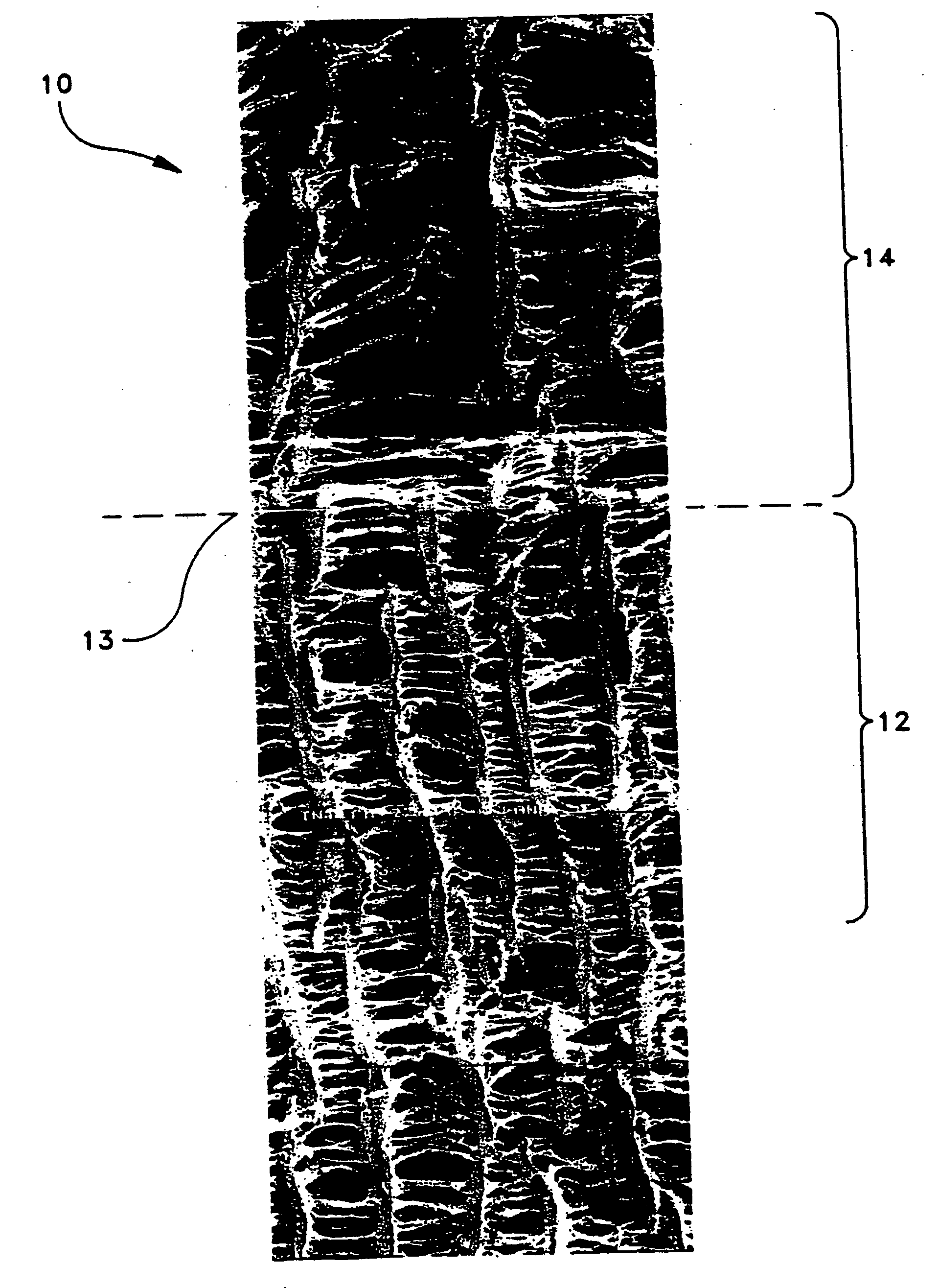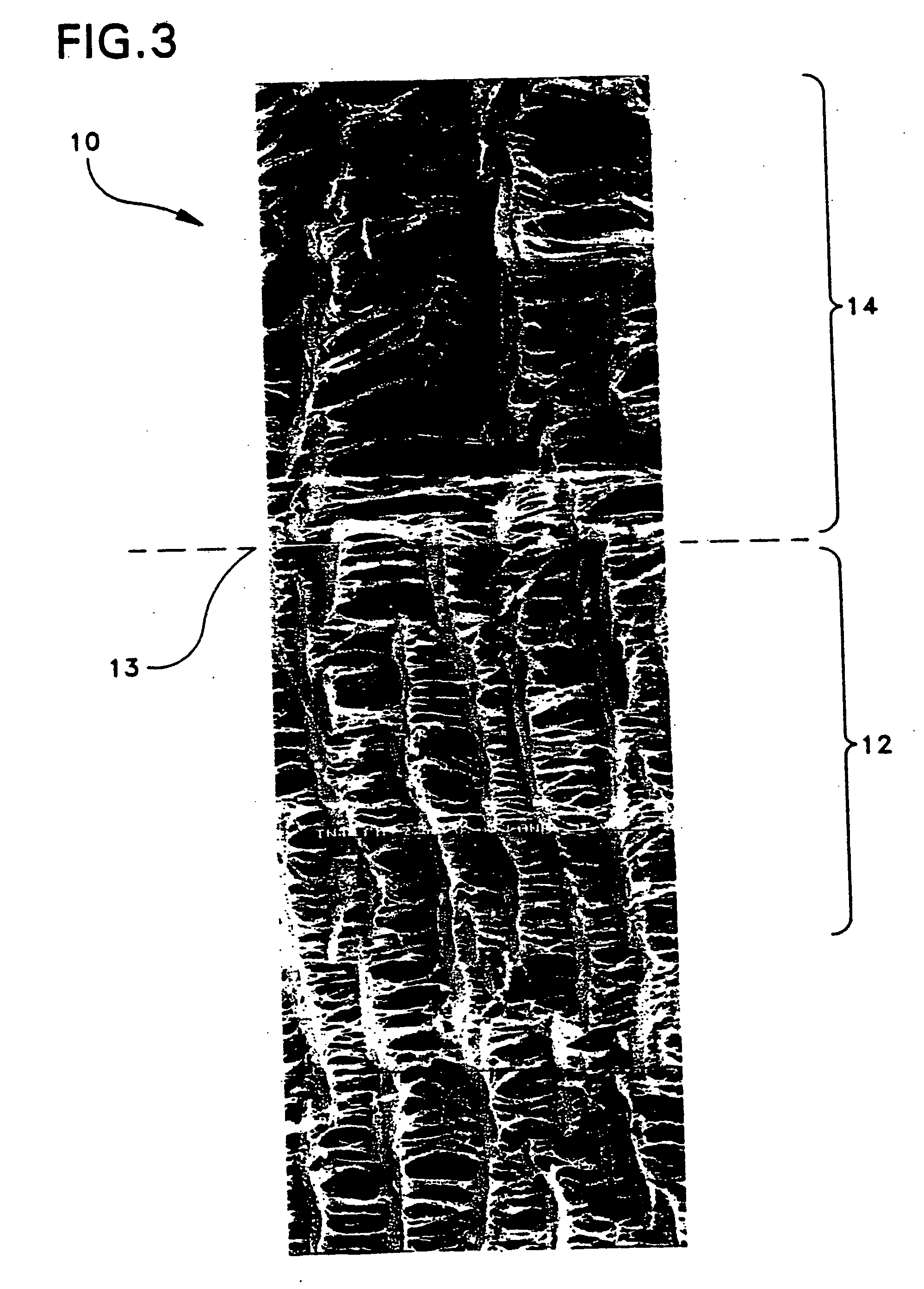Self-sealing PTFE vascular graft and manufacturing methods
a vascular graft and self-sealing technology, applied in the field of vascular grafts, can solve the problems of reducing the overall radial tensile strength of the tube, reducing the ability of the graft to retain a suture, and low axial tear strength
- Summary
- Abstract
- Description
- Claims
- Application Information
AI Technical Summary
Benefits of technology
Problems solved by technology
Method used
Image
Examples
example 2
[0060] A thin extruded tube having wall thickness of 0.41 mm and an inner diameter of 6.2 mm was expanded over a stainless steel mandrel at 500.degree. F. to 700% elongation. The ePTFE tube was then sintered at 660.degree. F. for 14 minutes, cooled, and removed from the oven. A second thin extruded tube having wall thickness of 0.45 mm and an inner diameter of 6.9 mm was expanded over the first tube at 500.degree. F. and 400% elongation. The composite was sintered at 660.degree. F. for 14 minutes, cooled, and removed from the oven. The resultant composite tube had a wall thickness of 0.67 mm and an inner diameter of 5.8 mm.
[0061] Table I presents physical property data for a vascular graft of the type depicted in Example I described above. The composite graft was removed from the mandrel and subjected to standard testing of radial tensile strength and suture hole elongation. The radial strength of the 900% / 400% composite graft is equivalent to a single layer 400% elongation graft an...
example 3
[0062] Three composite grafts were constructed and their ability to reseal after a puncture was tested. Graft No. 1 is an ePTFE helically tape-wrapped graft with no resealable layer, and graft Nos. two (2) and three (3) were constructed with a resealable intermediate layer in the below-described procedure.
[0063] Graft No. 1 is an ePTFE graft used as the control in the following experiment. Graft 2 was constructed by first placing an ePTFE tubular structure with an inner diameter of 5 millimeters on a mandrel. A thermoplastic elastomer tubing was then slid over the ePTFE tube. Because of the tackiness of the thermoplastic elastomeric tubing, it was necessary to manipulate the tubing by rolling and stretching it in order to maneuver it over the first ePTFE tubular structure to lie evenly thereon. A second ePTFE tubular structure with an inner diameter of five (5) millimeters was then radially stretched, or expanded to yield an ePTFE tubular structure with an inner diameter of 8 millim...
example 4
[0068] Three additional grafts were constructed with an intermediate resealable layer and tested to determine their ability to seal after puncture.
[0069] Graft No. 4 was made using an ePTFE graft with an initial 5 millimeter inner diameter as the inner tubular structure. The 5 mm ePTFE tube was extruded using a die insert of 0.257 inches, and a mandrel of 0.226 inches. The inner tube was then stretched longitudinally to 500% its original length, and sintered. The inner tube was then stretched radially by placing it on a 5.95 mm mandrel. A pre-sintered PTFE bead-wrap (0.014 inch.+-.0.002 inch diameter, length approximately 30 cm) was then helically wrapped around the exterior of the inner tube at 650 revolutions per minute (RPM), and with a mandrel speed traversely at 800 RPMs. The wrap helically repeated on the tube at approximately every 3.5 cm, and at an angle of approximately 10.degree.-50.degree. with respect to a radial axis. After wrapping, the coil wrapped tube was then heate...
PUM
| Property | Measurement | Unit |
|---|---|---|
| elongation | aaaaa | aaaaa |
| elongation | aaaaa | aaaaa |
| elongation | aaaaa | aaaaa |
Abstract
Description
Claims
Application Information
 Login to View More
Login to View More - R&D
- Intellectual Property
- Life Sciences
- Materials
- Tech Scout
- Unparalleled Data Quality
- Higher Quality Content
- 60% Fewer Hallucinations
Browse by: Latest US Patents, China's latest patents, Technical Efficacy Thesaurus, Application Domain, Technology Topic, Popular Technical Reports.
© 2025 PatSnap. All rights reserved.Legal|Privacy policy|Modern Slavery Act Transparency Statement|Sitemap|About US| Contact US: help@patsnap.com



